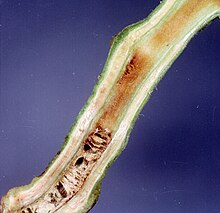
Back رالستونية باذنجانية Arabic رالستينيه باذنجانيه ARZ Ralstonia solanacearum Czech Ralstonia solanacearum German Ralstonia solanacearum Spanish Ralstonia solanacearum French 青枯病菌 Japanese വാട്ടരോഗം Malayalam Ralstonia solanacearum Polish Mörk ringröta Swedish
| Ralstonia solanacearum | |
|---|---|

| |
| Damage caused by Ralstonia solanacearum on tomato stem | |
| Scientific classification | |
| Domain: | Bacteria |
| Phylum: | Pseudomonadota |
| Class: | Betaproteobacteria |
| Order: | Burkholderiales |
| Family: | Burkholderiaceae |
| Genus: | Ralstonia |
| Species: | R. solanacearum
|
| Binomial name | |
| Ralstonia solanacearum | |
| Type strain | |
| ATCC 11696 CCUG 14272 | |
| Synonyms | |
|
Burkholderia solanacearum (Smith 1896) Yabuuchi et al. 1993 | |
Ralstonia solanacearum is an aerobic non-spore-forming, Gram-negative, plant pathogenic bacterium. R. solanacearum is soil-borne and motile with a polar flagellar tuft. It colonises the xylem, causing bacterial wilt in a very wide range of potential host plants. It is known as Granville wilt when it occurs in tobacco. Bacterial wilts of tomato, pepper, eggplant, and Irish potato caused by R. solanacearum were among the first diseases that Erwin Frink Smith proved to be caused by a bacterial pathogen. Because of its devastating lethality, R. solanacearum is now one of the more intensively studied phytopathogenic bacteria, and bacterial wilt of tomato is a model system for investigating mechanisms of pathogenesis.[2][3] Ralstonia was until recently classified as Pseudomonas,[1] with similarity in most aspects,[4] except that it does not produce fluorescent pigment like Pseudomonas.[5] The genomes from different strains vary from 5.5 Mb up to 6 Mb, roughly being 3.5 Mb of a chromosome and 2 Mb of a megaplasmid.[6] While the strain GMI1000 was one of the first phytopathogenic bacteria to have its genome completed,[7] the strain UY031 was the first R. solanacearum to have its methylome reported.[6] Within the R. solanacearum species complex, the four major monophyletic clusters of strains are termed phylotypes, that are geographically distinct: phylotypes I-IV are found in Asia, the Americas, Africa, and Oceania, respectively.[2][6]
Ralstonia solanacearum was once considered as a possible biological control agent for Kahili ginger (Hedychium gardnerianum), a highly invasive species.[8] However, R. solanacearum is no longer used as a biological control for Kahili ginger in Hawaiian forests because of its wide host range. The ginger-parasitizing strain will infect numerous ginger species, including edible ginger (Zingiber officinale), shampoo ginger (Z. zerumbet), and pink and red ginger (Alpinia purpurata).[9]
- ^ a b Cite error: The named reference
Yabuuchi-et-al-1995was invoked but never defined (see the help page). - ^ a b Cite error: The named reference
Dennywas invoked but never defined (see the help page). - ^ Vailleau, Fabienne; Genin, Stéphane (2023-09-05). "Ralstonia solanacearum : An Arsenal of Virulence Strategies and Prospects for Resistance". Annual Review of Phytopathology. 61 (1): 25–47. doi:10.1146/annurev-phyto-021622-104551. ISSN 0066-4286. PMID 37506349.
- ^ Cite error: The named reference
Agrios-2005was invoked but never defined (see the help page). - ^ Agrios, George N. (2005). Plant pathology (5th ed.). Amsterdam: Elsevier Academic Press. p. 622. ISBN 0-12-044565-4. OCLC 55488155.
- ^ a b c Guarischi-Sousa, Rodrigo; Puigvert, Marina; Coll, Núria S.; Siri, María Inés; Pianzzola, María Julia; Valls, Marc; Setubal, João C. (15 January 2016). "Complete genome sequence of the potato pathogen Ralstonia solanacearum UY031". Standards in Genomic Sciences. 11 (1): 7. Bibcode:2016SGenS..11....7G. doi:10.1186/s40793-016-0131-4. PMC 4714475. PMID 26779304.
- ^ Salanoubat, M.; Genin, S.; Artiguenave, F.; Gouzy, J.; Mangenot, S.; Arlat, M.; Billault, A.; Brottier, P.; Camus, J. C.; Cattolico, L.; Chandler, M.; Choisne, N.; Claudel-Renard, C.; Cunnac, S.; Demange, N.; Gaspin, C.; Lavie, M.; Moisan, A.; Robert, C.; Saurin, W.; Schiex, T.; Siguier, P.; Thébault, P.; Whalen, M.; Wincker, P.; Levy, M.; Weissenbach, J.; Boucher, C. A. (31 January 2002). "Genome sequence of the plant pathogen Ralstonia solanacearum". Nature. 415 (6871): 497–502. doi:10.1038/415497a. PMID 11823852.
- ^ Andersona, R. C.; Gardner, D. E. (1999). "An Evaluation of the Wilt-Causing Bacterium Ralstonia solanacearum as a Potential Biological Control Agent for the Alien Kahili Ginger (Hedychium gardnerianum) in Hawaiian Forests". Biological Control. 15 (2): 89–96. Bibcode:1999BiolC..15...89A. doi:10.1006/bcon.1999.0705.
- ^ Paret, M.L.; de Silva, A.S.; Criley, R.A.; Alvarez, A.M. (2008). "Ralstonia solanacearum Race 4:Risk Assessment for Edible Ginger". HortTechnology. 18: 90–96. doi:10.21273/HORTTECH.18.1.90.